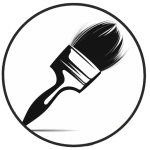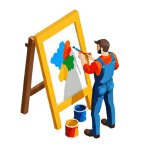Welcome to Painting Inspiration: A Guide on How to Paint
Introduction
Welcome, painters! Whether you are a beginner looking to explore the world of painting or an experienced artist seeking new inspiration, this self-guided online lesson is designed to help you unleash your creativity and enhance your painting skills. The goal of Painting Inspiration is to provide you with a comprehensive guide on how to paint, offering step-by-step instructions, techniques, and tips to help you express your artistic vision through the medium of painting.
When it comes to choosing your painting supplies, it's essential to select high-quality materials that will help you achieve the desired results in your artwork. Here are some key factors to consider:
1. Paints: Invest in artist-grade paints for better color intensity and longevity. Consider whether you prefer acrylics, oils, watercolors, or any other type based on your painting style and technique.
2. Brushes: A variety of brush sizes and shapes are necessary for different painting techniques. Ensure your brushes are suitable for the type of paint you are using.
3. Canvas or Paper: Choose the appropriate surface for your painting, whether it be canvas for oils and acrylics or watercolor paper for watercolors.
4. Palette: A palette for mixing paints is essential. You can use a traditional wooden palette, a disposable palette pad, or even a glass palette for easy cleanup.
5. Easel: A sturdy easel will provide a comfortable working position and help you maintain proper posture while painting.
6. Other Supplies: Don't forget essentials like paint thinner, water jars, rags, masking tape, and a pencil for sketching your ideas before painting.
By carefully selecting your painting supplies, you set yourself up for success and ensure that your painting techniques can shine through in your artwork.
Setting up your painting space is essential to ensure a smooth and enjoyable painting experience. Here are some key steps to create an ideal workspace:
1. Choose a Well-Lit Area: Select a room with ample natural light or invest in good-quality artificial lighting. Proper lighting is crucial for accurately assessing colors and details in your painting.
2. Cover and Protect Surfaces: Lay down a drop cloth or old sheets to protect your floors and furniture from paint spills or splatters. This will also make cleaning up easier once you're done painting.
3. Organize Your Supplies: Keep all your painting supplies within reach. Arrange your brushes, paints, palette, and other tools in a way that is convenient for you to access while working.
4. Set Up Your Easel: If you're using an easel, ensure it is stable and at a comfortable height for painting. Adjust the angle of the easel to suit your painting style and preferred working position.
5. Ventilate the Space: Painting often involves working with fumes from paints and solvents. Ensure good ventilation in your painting area by opening windows or using a fan to maintain air circulation.
6. Stay Organized: Keep your painting space tidy and organized throughout your painting session. This will help you focus on your artwork without distractions and prevent accidents due to clutter.
By following these steps to set up your painting space, you can create a comfortable and functional environment that enhances your painting techniques and creativity.
Exploring different painting techniques can enhance your artistic skills and bring a new dimension to your artwork. Here are some popular painting techniques to experiment with:
1. Brush Techniques: Experiment with various brush sizes, shapes, and textures to create different effects on your canvas. Practice techniques such as stippling, dry brushing, and blending to achieve unique textures and color gradients.
2. Palette Knife Techniques: Using a palette knife can add depth and texture to your paintings. Try applying paint directly from the palette knife onto the canvas, or use the knife to create intricate patterns and details.
3. Wash Techniques: Create translucent layers of color by using a wash technique. Dilute your paint with water to achieve a fluid consistency, then apply it to the canvas in smooth, overlapping strokes to build up depth and complexity.
4. Impasto Techniques: Impasto involves applying thick layers of paint onto the canvas to create a textured, three-dimensional effect. Experiment with different tools, such as palette knives or brushes, to build up rich layers of paint.
By exploring these painting techniques and practicing regularly, you can develop your own unique style and take your artwork to the next level. Don't be afraid to experiment and push the boundaries of traditional painting methods!
When embarking on a painting project, finding inspiration is essential for unleashing your creativity and giving life to your artwork. Here are some effective ways to find inspiration for your painting:
1. Nature: Take a walk in the park, visit a botanical garden, or simply sit in your backyard and observe the natural world around you. The colors, shapes, and textures in nature can provide endless inspiration for your paintings.
2. Art Galleries and Museums: Explore local art galleries and museums to view the works of renowned artists. Studying different styles and techniques can spark new ideas and help you develop your own unique painting style.
3. Photography: Browse through photography books or online platforms to discover captivating images that resonate with you. Use these photographs as references or starting points for your paintings.
4. Emotions and Memories: Reflect on your own emotions, experiences, and memories. Channeling your feelings into your artwork can add depth and authenticity to your paintings.
5. Experimentation: Don't be afraid to experiment with different mediums, techniques, and styles. Trying new approaches can lead to unexpected sources of inspiration and help you push the boundaries of your creativity.
By exploring these sources of inspiration, you can fuel your passion for painting and unlock a world of creative possibilities. Remember that inspiration can come from anywhere, so stay open-minded and receptive to the beauty and wonder that surrounds you.
When it comes to creating your masterpiece through painting, it's essential to focus on your painting techniques. Here are some tips to help you elevate your art to the next level:
1. Experiment with Different Brushes: The type of brush you use can greatly impact the outcome of your painting. Try using different brushes to create various textures and effects in your artwork.
2. Play with Color and Light: Understanding how colors interact with each other and how light affects your painting can help you create depth and dimension in your artwork. Experiment with different color schemes and lighting techniques to see what works best for your masterpiece.
3. Practice Patience and Precision: Painting is a skill that requires patience and attention to detail. Take your time with each brushstroke and pay attention to the precision of your work. This will help you create a polished and professional-looking masterpiece.
4. Find Inspiration and Make it Your Own: Draw inspiration from the world around you, whether it's nature, art, or everyday life. Take that inspiration and make it your own by adding your unique style and perspective to your painting.
5. Embrace Mistakes and Learn from Them: Mistakes are a natural part of the artistic process. Embrace them, learn from them, and use them to improve your painting techniques. Remember that every mistake is an opportunity to grow as an artist.
By incorporating these tips into your painting process, you can create a masterpiece that truly reflects your creativity and talent. Keep experimenting, practicing, and pushing yourself to new heights in your artistic journey.
Embracing Painting Inspiration for Your Creative Outlet
As we conclude this lesson on painters and the significance of painting inspiration, let us not forget the essence of using art as a creative outlet. By exploring different techniques, styles, and approaches, we can tap into our inner creativity and express ourselves through the canvas.
Review and Revisit for Continued Growth
Should you need a refresher or seek further guidance on achieving your painting goals, feel free to revisit this lesson. Remember that practice and patience are key in the journey towards harnessing your artistic inspiration.
Explore More Lessons
Our course offers a variety of lessons covering different aspects of painting. Delve into these resources to expand your knowledge and enhance your skills as a painter.
Lesson Audio

